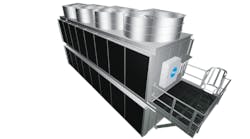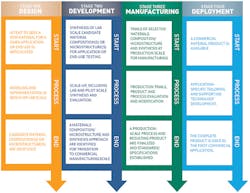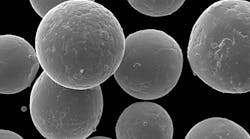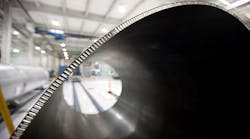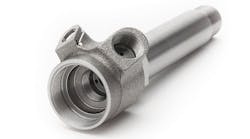Every forging represents the culmination of a long sequence of objectives and propositions, frequently demanding the contributions of multiple organizations and dozens of individuals. The finished forging is combination of extensive research efforts into design requirements, material needs, and process determination. Recently, QuesTek Innovations LLC published a detailed review of its seven-year effort to guide development and certification of a critical part for a U.S. Navy fighter aircraft.
QuesTek’s Ferrium® M54® steel is now in use forming hook shanks, part of the tailhook system that is used to achieve quick deceleration of jets landing on aircraft carrier decks.
In 2007, QuesTek developed Ferrium M54 in response to a U.S. Navy Small Business Innovation Research (SBIR) solicitation for a lower-cost, improved alternative to then-current materials, such as 4340, 300M, and Aermet® 100. The Navy’s request specifically called for designing the alloy through modeling and simulation, with feasibility confirmed through limited coupon testing. As the development process proceeded, and in response to the needs of the U.S. Navy, the effort shifted to developing a replacement for HY-TUF steel used in the T-45 hook shank on U.S. Navy carrier aircraft.
While QuesTek — an Integrated Computational Materials Engineering (ICME) specialist— provided materials and process design expertise and overall project management for the Ferrium M54 hook shank project, it enlisted several partners to produce the material and the T-45 hook shank itself, including: Latrobe Specialty Metals (later acquired by Carpenter Technology), SIFCO Forge, Bodycote, and Pankl Aerospace Systems.
QuesTek developed and published a “Reverse Roadmap” detailing the entire process of developing Ferrium M54 finalizing and qualifying the hook shank, depicting in close detail the events over time with reference to the design, development, manufacturing, and deployment of the final forged product.
Design Stage — The design stage took place from January to October 2007, beginning with QuesTek’s response to the Navy’s SBIR solicitation (N07-032), “Innovative Material for Enhancing Landing Gear Life”. Having gained the contract, QuesTek developed a “materials performance requirements matrix ” for the improved alloy, then generated and computationally designed materials to meet the requirements.
The Reverse Roadmap
QuesTek’s proprietary databases were critical to modeling alloy compositions, and led to identifying the M54 alloy composition as the most promising material for the part requirements, leading to “bench-scale melting” and evaluation in the development stage.
Development Stage — Overlapping the end of the design stage, the development stage spanned September 2007 to December 2009, and included a materials specification and process for transition to full-scale manufacturing. Intellectual property protection efforts also took place, including filing a provisional patent in 2008 and a more complete filing in early 2009. The patent was issued in 2015.
During the development stage, QuesTek used in-house prototyping to evaluate the M54 composition. It also documented the material’s microstructures and mechanical performance, leading up to the specification of a pilot material composition that was produced in a 1500-lb. heat by Metalwerks (a high-tech materials vacuum-melting operation) and processed into articles for heat treatment process testing.
Processing details identified by in the development stage were supported by QuesTek’s “design for scale” modeling capability, which then supported the casting process and subsequent thermo-mechanical processing needed for mechanical property evaluation and development of the materials and processing know-how.
Manufacturing Stage — The manufacturing stage was carried out from January 2010 through April 2014. It included enlisting partners to commercialize the M54 material and produce the hook shanks.
During the transition from development to manufacturing, additional SBIR funding became available through the T-45 platform, which allows continued progress on the M54 materials innovation: Phase II “option” funding to provide support for the continued scale-up activities and Phase II.5 funding to produce the hook shank application.
With funding secured, QuesTek moved forward with commercializing the M54 alloy. It licensed Latrobe Specialty Metals to produce it by vacuum induction melting and vacuum arc remelting (VIM/VAR.) Latrobe produced three 12-ton heats the M54 composition, which helped accelerate progress by providing materials for the hook shank components and making it possible to develop key material specifications.
Developing materials specifications is critical to producing high-performance alloys for “flight-critical applications,” because they are needed to obtain the required Aerospace Materials Specification designation. QuesTek obtained its AMS 6516 designation for the M54 alloy in early 2011.
As QuesTek standardized the manufacturing process and prepared M54 for commercial use, it also developed “design allowables,” including securing a Metallic Materials Properties Development and Standardization (MMPDS) allowable designation. It used the Accelerated Insertion of Materials (AIM) analysis technique along with data from three production heats to predict its MMPDS design minima, and this convinced the U.S. Navy’s T-45 program office to fund manufacturing and rig testing of three M54 steel landing gear hook shanks.
At this point, QuesTek initiated manufacturing the hook shanks. SIFCO Forge drew on its prior experience forging high-performance steels plus available flow-stress data to assist in forging modeling. SIFCO also had specific experience in forging hook shanks, and had developed a new forging die for hook shank forging that incorporated flow stress considerations for M54.
Bodycote heat-treated the hook shank components, with an equipment set-up well matched to the M54 alloy’s needs well. Separate experience heat-treating another M54 part (for an oil-and-gas application) also helped accelerate the process flow.
Prior to machining the hook shank parts, a machining comparison of M54 and Aermet® 100 was conducted, to develop production parameters. As processing moved to the machining of the actual heat treated M54 parts, some machining issues arose, including changes in parameters related to earlier studies on materials with a lower hardness (Rc 40, versus RC 54 in the actual parts), as well as the geometry of the final design’s thin-walled sections. In addition, inexperience on the part of the tooling supplier with the M54 material was an inhibitor. Pankl Aerospace Systems helped to accelerate the process with its new-model machining equipment.
QuesTek also worked on other applications for the M54 alloy, including a case running tool for oil-and-gas applications and input shafts for a racing application. It notes now that these parallel developments provided valuable technical detail for processing of M54.
Late in the manufacturing stage, three hook shanks were completed, one of which was fully assembled and painted. At last, the initial hook shanks were available for testing by the U.S. Navy.
Deployment Stage — The deployment stage lasted from September 2014 to December 2015, starting with a production order for 40 hook shanks. This period also included the first flight using the M54 hook shank.
SIFCO forged the hook shank parts once series production began, with on-site support from the QuesTek metallurgical staff. Heat-treating at Bodycote proceeded with no problems, and Pankl Aerospace’s machining and final assembly experienced some delays due to the need to coordinate downstream suppliers for process steps, such as shot peening, assembly of bushings and bearings, and Cd plating. In any case, the assembled hook shanks were completed by the end of 2015, ahead of the March 2016 delivery date.
Thanks to the efforts of QuesTek and its partners, Ferrium M54 is now a premium-quality steel that offers ultra-high strength and toughness. Rig testing of prototype components demonstrated a more than doubled lifespan compared with HY-TUF, steel and the U.S. Navy has estimated a $3 million savings from implementing the M54 product into its T-45 hook shanks. Further applications for Ferrium M54 Steel include aircraft landing gear and arresting tailhooks, shock struts, tow bars, drive shafts, actuators, blast containment devices, fasteners, oil and gas running cases, and other highly loaded components.
The “Reverse Roadmap” published by QuesTek Innovations was funded by the National Institute of Standards and Technology (NIST) and carried out by Nexight Group and Energetics Inc. It is available for download at http://bit.ly/2em5Szc








